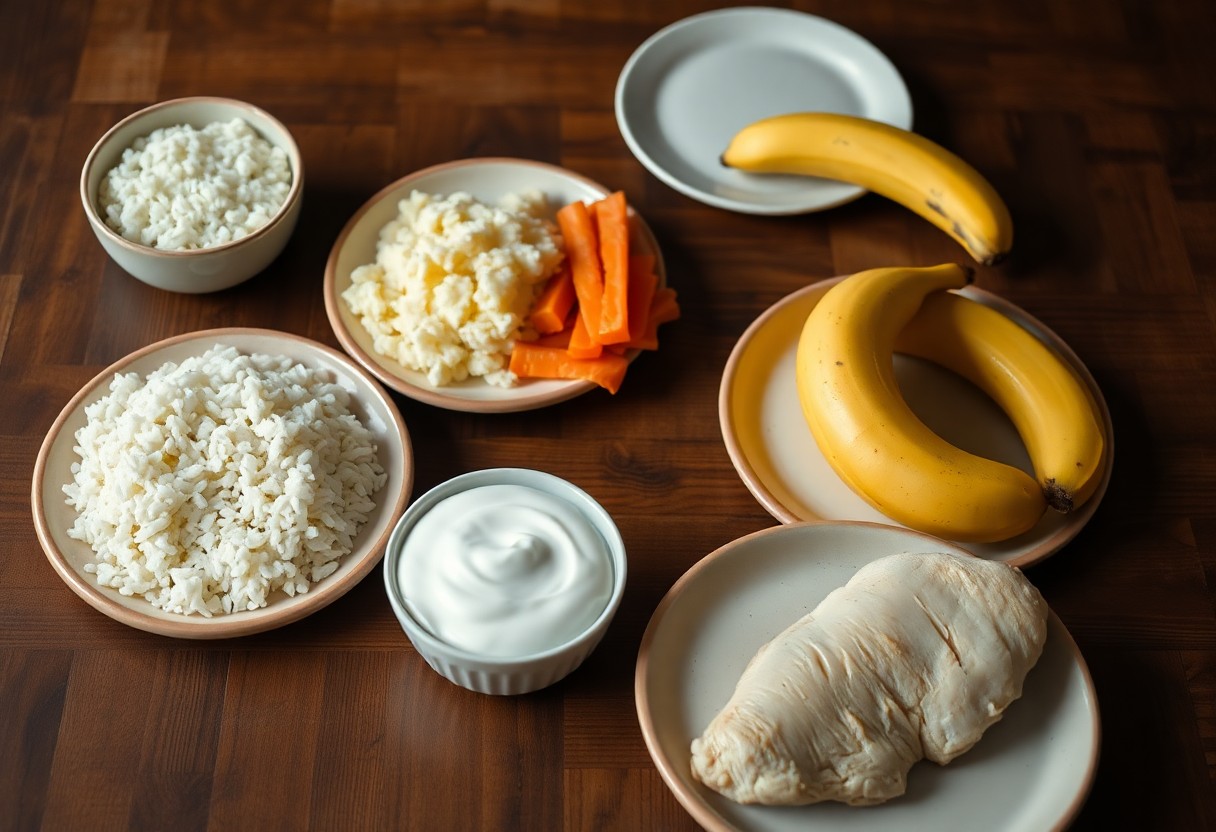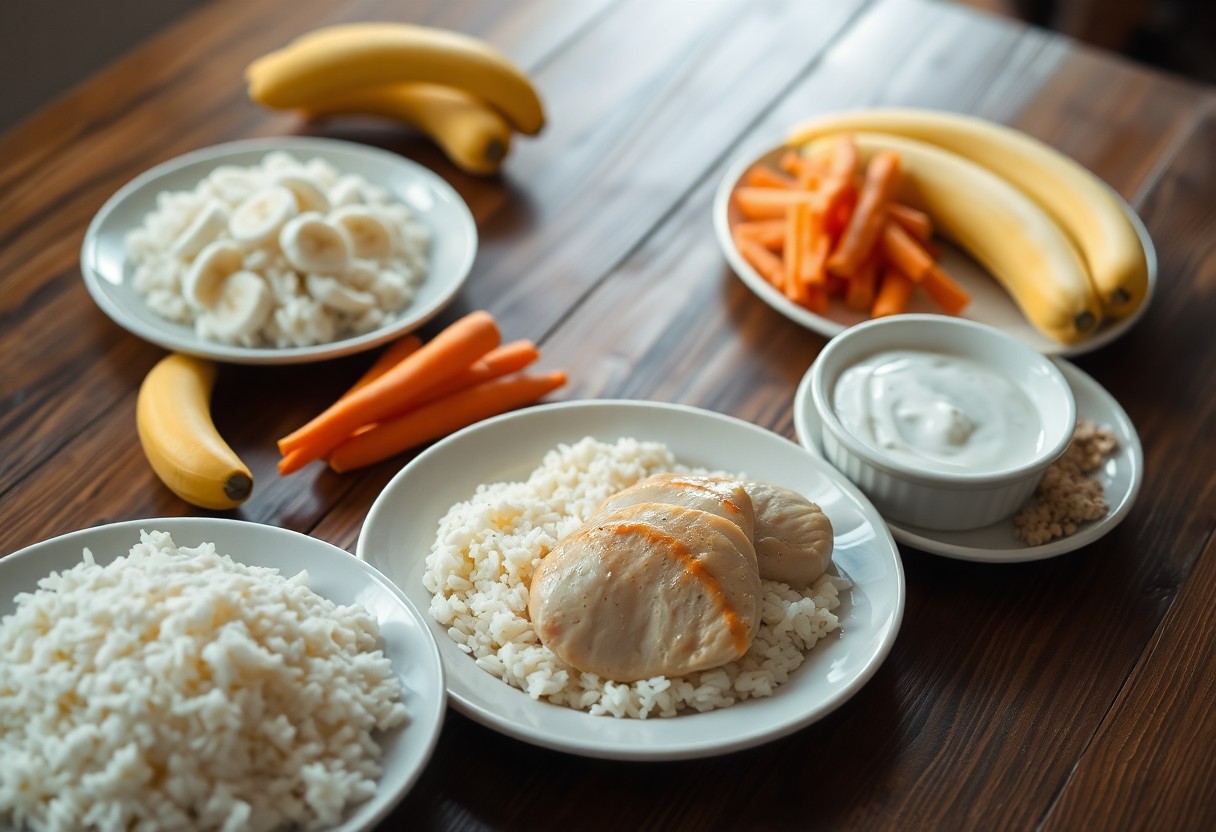With a sensitive stomach, choosing the right foods is vital for your comfort and well-being. Low fiber foods can help ease digestive issues, making meal planning a bit simpler. In this post, you’ll discover a variety of low fiber options that can fit seamlessly into your diet. These choices can provide nourishment without irritating your gastrointestinal system. For more detailed guidance on dietary choices, check out this resource on High-Fiber and Low-Fiber Foods.

Understanding Low Fiber Foods
While navigating dietary choices, understanding low fiber foods is vital, especially for those with sensitive stomachs. Low fiber foods are often easier for your digestive system to process, providing relief from discomfort and irritation. By prioritizing these foods, you can maintain a balanced diet while minimizing your stomach's workload, ensuring you feel your best.
Definition of Low Fiber Foods
Fiber is a type of carbohydrate that your body cannot digest. Low fiber foods typically contain minimal amounts of this nutrient, making them gentler on your digestive system. These foods often include refined grains, certain fruits, and tender vegetables, all of which can help avoid digestive stress.
Importance for Sensitive Stomachs
Understanding low fiber foods is key for individuals with sensitive stomachs. By opting for these foods, you can help reduce symptoms such as bloating, gas, and discomfort, often associated with a high fiber diet.
Consequently, incorporating low fiber foods into your diet allows you to manage your symptoms effectively. If you have a sensitive stomach, these foods can help promote a stable digestive environment, making it easier for you to enjoy meals without fear of discomfort. As you explore low fiber options, consider how each choice affects your body, and prioritize those that support your well-being.
Benefits of Low Fiber Diets
Even though fiber is often touted for its health benefits, a low-fiber diet can offer numerous advantages, especially for those with sensitive stomachs. By limiting fiber intake, you can reduce the workload on your digestive system, allowing for a more comfortable experience. This dietary approach can lead to improved nutrient absorption and a greater sense of well-being, particularly if you suffer from digestive issues.
Reduced Digestion Stress
The primary benefit of a low-fiber diet is the reduction of digestion stress. With fewer fibrous foods to process, your stomach can function more efficiently. This can lead to less bloating, gas, and discomfort, making meals more enjoyable and less taxing on your digestive system.
Alleviation of Gastrointestinal Symptoms
Diets low in fiber can provide significant relief from various gastrointestinal symptoms such as cramping, diarrhea, and constipation. This is especially beneficial if you have conditions such as irritable bowel syndrome (IBS) or other sensitivities. By choosing easy-to-digest foods, you can help balance your gut's functions and promote greater digestive comfort.
Plus, the alleviation of gastrointestinal symptoms often leads to a noticeable improvement in your quality of life. You may find that meals become less of a concern, allowing you to enjoy food without the fear of triggering discomfort. By focusing on low-fiber options, you can create a diet that not only suits your digestive needs but also supports your overall health and enjoyment of food.
Top Low Fiber Foods
After navigating dietary restrictions for sensitive stomachs, it’s necessary to discover low fiber options. Incorporating 10 Vegetables That Contain Close to Zero Grams of Fiber ... can help you maintain digestive comfort while ensuring nutritious intake.
Fruits
Behind many fruits lies a lower fiber profile, which can be beneficial for your digestive system. Fruits like bananas, honeydew melon, and canned peaches provide hydration and necessary vitamins without taxing your stomach.
Vegetables
About low fiber vegetables, options such as zucchini, cucumbers, and cooked carrots are gentle on your digestive system. These vegetables can be cooked to reduce fiber content further, making them easier to digest.
Plus, including low fiber vegetables in your diet can encourage nutrient absorption without irritation. They provide vitamins and minerals that support overall health while minimizing digestive discomfort.
Grains and Cereals
Around grains and cereals, white rice, plain pasta, and refined bread present themselves as low fiber choices. These options are generally easier to digest than their whole grain counterparts, helping you manage any digestive issues.
Understanding the impact of grains on your diet can be helpful. Choosing refined grains may offer a gentler alternative, allowing you to enjoy meal variety while prioritizing your digestive comfort.
Dairy Products
On the topic of dairy products, options like yogurt, cream cheese, and mozzarella can be suitable for your low fiber needs. These foods can provide necessary calcium and protein without overwhelming your digestive system.
Another benefit of incorporating dairy products is that they often contain probiotics, which may help support gut health. Opting for low-fat varieties can also assist in managing your overall dietary intake.
Proteins
For protein sources, lean meats, fish, and eggs serve as low fiber alternatives that keep your energy levels steady while being easier on your stomach. These foods are vital for recovery and muscle maintenance.
This choice allows you to build a balanced plate without fiber-related discomfort. You can enjoy nutrient-rich proteins while catering to your specific dietary requirements.
Cooking Methods for Low Fiber Foods
All cooking methods play a vital role in preparing low fiber foods that are gentle on your sensitive stomach. Selecting the right technique can help you create meals that are not only digestible but also delicious. Simple methods like boiling and steaming, as well as baking and roasting, can preserve nutrients while keeping fiber levels low. Choose techniques that allow you to enjoy your favorite foods in a way that supports your digestive health.
Boiling and Steaming
Against popular belief, boiling and steaming can enhance the digestibility of low fiber foods. By cooking vegetables and grains in water or steam, you break down tough cellular structures, making them easier for your stomach to handle. This method helps to soften foods without adding any fats or unnecessary ingredients, ensuring they remain low in fiber and gentle on your digestive system.
Baking and Roasting
Steaming is a great option, but baking and roasting also offer unique advantages when preparing low fiber meals. These dry cooking methods enable you to concentrate flavors and achieve a desired texture without introducing excess fiber. You can lightly season low fiber foods like chicken, fish, or tender vegetables for added taste. Keep an eye on cooking times, as you want to avoid overcooking, which can impact the digestibility of your meals. With the right balance of seasoning and temperature, baking and roasting can be delightful options for your sensitive stomach.

Tips for Transitioning to a Low Fiber Diet
For a smooth transition to a low fiber diet, it's important to approach the change thoughtfully. Start by prioritizing easily digestible foods and gradually reduce fiber intake to avoid gastrointestinal discomfort. Keep these tips in mind:
- Consult with a healthcare provider or dietitian for personalized advice.
- Introduce low fiber options slowly and systematically.
- Choose well-cooked vegetables and ripe fruits.
- Stay hydrated to support digestion.
The adjustments you make now can lead to better digestive health.
Gradual Changes
Before making significant dietary changes, consider implementing gradual modifications to ease your system into a low fiber diet. Start by swapping high-fiber foods with lower-fiber alternatives, such as white bread instead of whole grain, or peeled fruits instead of those with skins.
Monitoring Symptoms
The process of transitioning can bring about changes in how you feel. Keeping track of your symptoms allows you to identify which foods are beneficial and which ones may cause discomfort. This careful observation is key to finding the most suitable diet for your sensitive stomach.
For instance, take note of any bloating or discomfort when introducing new foods. Keeping a food diary can help you pinpoint which low fiber foods work well for you and which do not. Adjust your intake accordingly, and consider discussing your findings with a healthcare provider to ensure you're on the right track.
To wrap up
Upon reflecting, it's clear that choosing top low fiber foods can significantly aid those with sensitive stomachs like yours. Incorporating these foods can alleviate discomfort and promote easier digestion while still providing necessary nutrients. You can explore more about managing your dietary choices by visiting the Low-fiber diet: MedlinePlus Medical Encyclopedia. By being mindful of your food selections, you empower yourself to maintain a balanced and manageable diet for your unique digestive needs.
FAQ
Q: What are low fiber foods, and why are they important for sensitive stomachs?
A: Low fiber foods are those that contain minimal dietary fiber, making them easier to digest. For individuals with sensitive stomachs, such as those suffering from Irritable Bowel Syndrome (IBS) or Crohn's disease, consuming low fiber foods can help reduce irritation and discomfort in the digestive system. These foods can minimize bloating, gas, and cramping, which are common symptoms associated with high fiber diets.
Q: Which fruits are considered low fiber options for sensitive stomachs?
A: Some low fiber fruits that are gentle on sensitive stomachs include bananas, applesauce, canned peaches, and ripe melons such as cantaloupe and honeydew. These fruits are easier to digest and provide imperative vitamins without causing excessive gastrointestinal distress.
Q: What are some low fiber vegetable choices suitable for those with sensitive stomachs?
A: Vegetables that are low in fiber and suitable for individuals with sensitive stomachs include carrots, zucchini, and cooked spinach. Cooking these vegetables often makes them easier to digest compared to their raw counterparts. It is advisable to avoid high-fiber vegetables like broccoli and beans, which can lead to gas and bloating.
Q: Are there any low fiber grains that can be recommended?
A: Yes, when it comes to grains, options such as white rice, plain pasta, and refined white bread are typically low in fiber and easier to digest. It is best to steer clear of whole grain products, as they usually contain higher levels of fiber that could potentially irritate a sensitive stomach.
Q: What protein sources are low in fiber and suitable for people with sensitive stomachs?
A: Low fiber protein sources appropriate for sensitive stomachs include lean meats such as chicken and turkey, fish, eggs, and dairy products like yogurt and cheese. These options provide imperative nutrients without adding significant fiber content that could lead to discomfort.







0 Comments